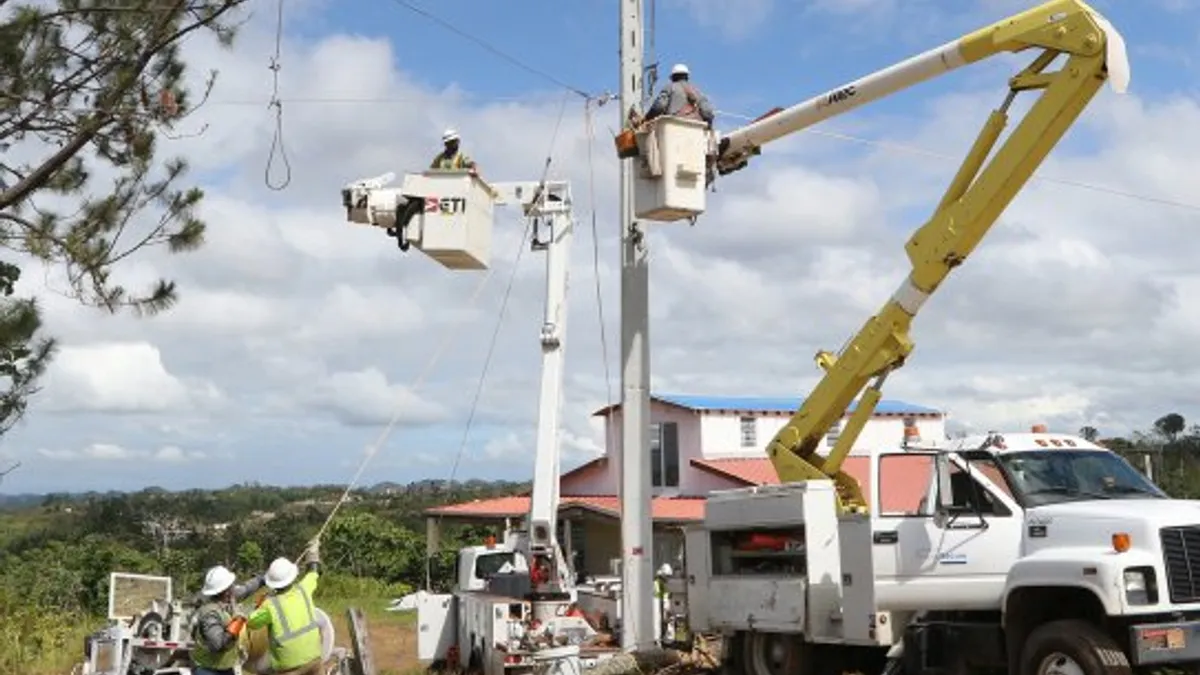Dive Brief:
- LUMA Energy began operating Puerto Rico's electric grid on Tuesday, managing the system through a public-private partnership that aims to save customers money, improve the island's resilience and add renewable power.
- LUMA, owned by ATCO and Quanta Services, takes over for the bankrupt Puerto Rico Electric Power Authority (PREPA), which will continue to own the island's grid assets.
- Observers question whether LUMA is prepared to operate the grid, however, and if the company has been able to hire sufficient linemen from PREPA's ranks. "The transition has not been managed well, particularly from a workforce standpoint," Cathy Kunkel, an analyst at the Institute for Energy Economics and Financial Analysis (IEEFA), said.
Dive Insight:
Almost four years after Hurricane Maria destroyed Puerto Rico's electrical system, setting in motion plans to rebuild it stronger and cleaner, LUMA's takeover marks a major step forward. But the utility takeover has been marred by labor controversy, and it is unclear if the new utility will have enough workers to maintain the system.
More than half of PREPA's workforce is not transferring to LUMA, according to Kunkel, and only 250 linemen have accepted offers to work for the new company, a figure also reported by Bloomberg. Because PREPA is a government entity, it is more difficult to let workers go and there have been reports of seemingly random reassignments.
"It's a huge loss of human capital," said Kunkel, "particularly starting this contract at the beginning of hurricane season."
The North Atlantic hurricane season begins June 1.
Transitioning the grid from PREPA to LUMA's management was "immensely difficult and unprecedented," Roy Torbert, a principal in Rocky Mountain Institute's Africa, Islands and Southeast Asia program, said in an email. But, he added, "they don't yet seem fully prepared, particularly given the myriad of risks from the new hurricane season and ongoing COVID challenges."
LUMA officials are "making a good effort to engage with many stakeholders and the regulator, which will be key for their success," Torbert said.
LUMA did not address questions regarding staffing, but issued a statement saying the company is "ready to serve all electric service customers with excellence and transform the network that illuminates Puerto Rico."
Customers are unlikely to experience immediate changes due to the switchover, said Torbert. And LUMA has has focused on "training, pre-positioning of assets, improving planning processes, and other investments to prepare their team" to take over things like vegetation management, he said.
"Given the risks to the fragile grid – we believe that investing in resilience at multiple levels, including microgrids for critical facilities, should be a top priority," Torbert said. As LUMA undertakes an Integrated Resource Planning process, Torbert recommended "improving the analytical treatment of resilience as well as considering distributed and [virtual power plant] solutions."
Puerto Rico has targeted 100% renewable energy by 2050. IEEFA has previously questioned whether the island's contract with LUMA will allow it to meet those goals without significantly raising electricity prices.
LUMA has said it expects to save customers about $110 million by 2024, by operating the grid more efficiently.
Looking ahead, the federal government under President Trump authorized $9.6 billion to rebuild Puerto Rico's power infrastructure and Kunkel said there are questions about how that will be spent. The utility issued a request for proposals for renewables and storage, she said, "but there's a real question of why are they not using any of the federal funds available for that purpose, when FEMA said they could."
Torbert said the management and oversight of the renewable energy bidding process is critical.
"Improving clarity and confidence in that process should be a high priority, to allow for low-cost projects from reputable bidders to emerge, and to allow for inclusion of both grid-scale and distributed renewables," he said.














